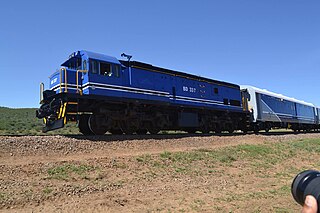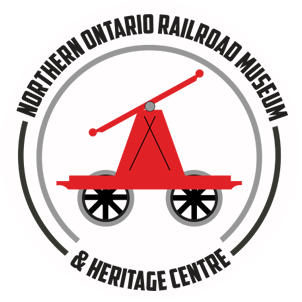
A Garratt locomotive is a type of steam locomotive invented by British engineer Herbert William Garratt that is articulated into three parts. Its boiler, firebox, and cab are mounted on a centre frame or "bridge". The two other parts, one at each end, have a pivot to support the central frame; they consist of a steam engine unit – with driving wheels, trailing wheels, valve gear, and cylinders, and above it, fuel and/or water storage.

The National Railways of Zimbabwe (NRZ), formerly Rhodesia Railways (RR), is a Bulawayo headquartered state-owned enterprise that operates the country's national railway system. It was established in 1893 and is governed by an Act of Parliament. It has a commercial-administrative center in Harare and a supply center in Gweru. The Zimbabwean railway system was largely constructed during the 20th century.
Indian Railways operates India's railway system and comes under the purview of the Ministry of Railways of Government of India. As of 2023, it maintains over 108,706 km (67,547 mi) of tracks and operates over 13,000 trains daily with a fleet of 14,800 locomotives. The railways primarily operates a fleet of electric and diesel locomotives along with a few compressed natural gas (CNG) locomotives. Steam locomotives are operated on mountain railways and on heritage trains.

Botswana Railways (BR) is the national railway of Botswana.

Rail services in Botswana are provided by Botswana Railways in Botswana. Most routes in the country radiate from Gaborone. The railway network consists of 888 km, its gauge is 1,067 mm cape gauge.

The Virginia Museum of Transportation (VMT) is a museum in Downtown Roanoke, Virginia, that is devoted to the topic of transportation.

The Mulobezi Railway was constructed to carry timber from Mulobezi to Livingstone in the Southern Province of Zambia, when the country was Northern Rhodesia. The line uses the 1,067 mm narrow gauge, also known as 'Cape gauge', shared by all main line railways in Southern Africa.

The South African Railways Class NG15 2-8-2 is a class of narrow-gauge steam locomotives.

Under the Whyte notation for the classification of steam locomotives by wheel arrangement, 2-6-2+2-6-2 is an articulated locomotive using a pair of 2-6-2 power units back to back, with the boiler and cab suspended between them. The 2-6-2 wheel arrangement has a single pair of leading wheels in a leading truck, followed by three coupled pairs of driving wheels and a pair of trailing wheels in a trailing truck.

Under the Whyte notation for the classification of steam locomotives by wheel arrangement, the 4-6-4+4-6-4 is a Garratt articulated locomotive. The wheel arrangement is effectively two 4-6-4 locomotives operating back to back, with the boiler and cab suspended between the two engine units. Each engine unit has two pairs of leading wheels in a leading bogie, followed by three coupled pairs of driving wheels and two pairs of trailing wheels in a trailing bogie.

The Cardiff Locomotive Workshops is a rail yard and rolling stock facility located between Cockle Creek and Cardiff stations near Newcastle, on the Main North railway line in New South Wales, Australia.

The Northern Ontario Railroad Museum and Heritage Centre is a rail transport museum located in the community of Capreol in Greater Sudbury, Ontario, Canada. The museum's mandate states it is, "focused on the preservation of historical artifacts that pay tribute to the heritage of Northern Ontario and the history of the lumber, mining and railroading industries."

The South African Railways Class 19D 4-8-2 of 1937 was a steam locomotive.

The South African Railways Class 14 4-8-2 of 1913 was a steam locomotive.

The EAR 59 class is a class of oil-fired 1,000 mm gauge Garratt-type articulated steam locomotives. The 34 members of the class were built by Beyer, Peacock and Company in Manchester, England, for the East African Railways (EAR). They entered service in 1955–56, and were the largest, heaviest and most powerful steam locomotives to operate on any metre gauge railway in the world.

The South African Railways Class GMA 4-8-2+2-8-4 of 1954 is an articulated steam locomotive.

The Rhodesia Railways 15th class, was the second-largest class of Garratt locomotives, with 74 locomotives built. Only the Class GMA/GMAM of the South African Railways was more numerous at 120 locomotives.

The Rhodesia Railways 20th class, later Zambia Railways and National Railways of Zimbabwe 20th classes, were among the largest and most powerful steam locomotives in the southern hemisphere.

Beira-Bulawayo railway, also called Machipanda railway, Beira-Harare-Bulawayo railway and Beira railway, is a railway that connects the city of Beira, Mozambique, to the city of Bulawayo, in Zimbabwe. It is 850 km long, in a 1067 mm gauge.

The Rhodesia Railways 16A class, later Zambia Railways and National Railways of Zimbabwe 16A classes.




















